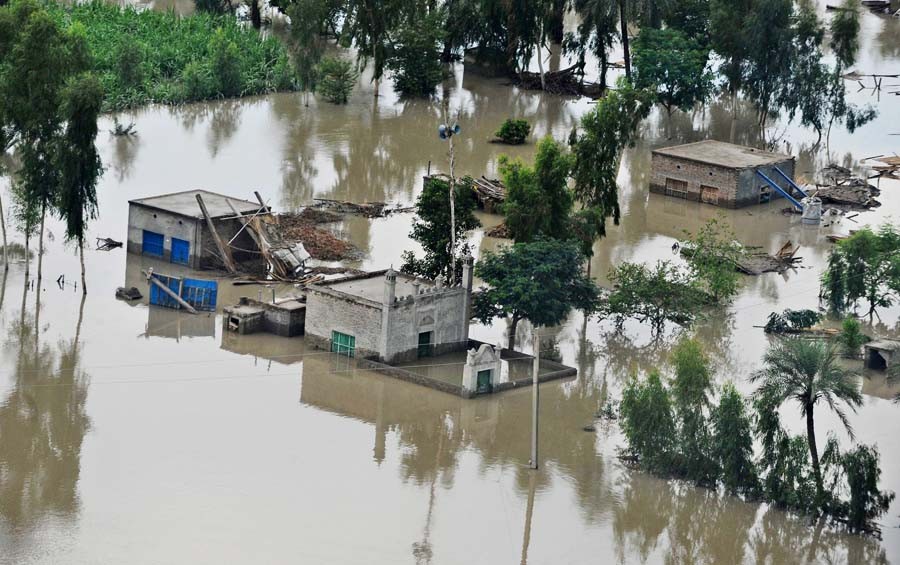
India’s recent violation of the Indus Water Treaty has spelt disaster for Pakistan

"Whenever the River Chenab floods, we are at risk. Water rushes towards our house as it thunders along the unpaved village streets."
Ameeran Bibi is a sixty-year-old widow and victim of the 2014 India-Pakistan floods that hit Kashmir, Gilgit-Baltistan and Punjab the hardest. She has first-hand experience of the devastation wrought upon the latter. For she lives in Basti Sunaki;in the Punjab; between Multan and Muzaffargarh and close to the Chenab’s western bank. She, along with others, lost her house. Little has changed since then. The region still faces two-fold challenges when it comes to flooding: discharge of water from India, and the destruction brought by hill torrents [Rodh Kohis] which develop as a result of heavy rains particularly in the Dera Ghazi Khan division.
Recalling how the deluge "literally washed away" the entire neighbourhood, Ameeran Bibi recalls that the Punjab Revenue Authority (PRA) surveyed the area, estimating the cost of damage but then left without compensating anyone. "We repaired our house with the help of the community." Yet chaos is knocking on her door once more.
On August 18, India unilaterally opened three out of five spillways of the Ladakh Dam as well as outlets of Alchi Dam; all without pre-schedule. This clear violation of the Indus Water Treaty has resulted in about 200,000 cusecs water being released into the River Sutlej. This has overwhelmed Pakistan’s river system. Not least because Alchi is considered the world’s highest dam.
Floodwater from the Indian side submerged the border village of Ganda Singh Wala in Kasur district; where a state of emergency has been declared. Elsewhere, more than 59 villages have been inundated in Okara, Gati Kalanger, Mastayki, and Bhikiwind Chachran Sharif and Kot Mithan. The National Management Disaster Authority (NDMA) issued emergency flood alerts for seven South Punjab districts: Multan, Vehari, Dera Ghazi Khan, Rajanpur, Muzaffargarh, Bahawalpur and Bahawalnagar. The Pakistan Army and Rescue 1122 officials are engaged in evacuation operations.
Yet the fear is that the Punjab has not weathered the worst of it. Concerns mount that nine administrative districts (mauzas) in Tehsil Jalalpur Pirwala, Multan district, will be consumed. These are critically located along the Sutlej River. In addition to declaring a flood emergency, the district administration is instructing locals to leave low-lying areas. A staggering 116 villages (in Vehari, Burewala and Mailsi) are expected to be flood-hit; with an anticipated 30,000 cusecs water reaching Head Islam in Vehari district. The deputy commissioner of Bahawalnagar, Muhammad Shoaib Khan Jadoon, confirms that some 15 camps have been set up, complete with medical facilities, to tackle disaster relief: five in tehsil Minchinabad, six in Bahawalnagar tehsil riverine belt areas and four in tehsil Chishtian.
Whether this will be sufficient remains to be seen. For civil society activists in South Punjab contend that more than nine public sector schools have been inundated; in Kot Mithan, Umar Kot and Rojhan. While local authorities admit that flooding in the Indus River and the hill torrents have consumed cotton fields spread over thousands of acres in low-lying areas; thereby highlighting the economic fallout of the disaster.
Local representation
The Punjab Local Government Act 2019 does not integrate the role of local government (LG) representatives in Disaster Risk Reduction (DRR). This runs contrary to National Disaster Management Authority (NDMA) Act 2010 provisions.
Chapter IV (District Disaster Management Authority) stipulates that the head of the local council at the district level shall be chairperson of the District Disaster Management Authority (DDMA).
Section 2 specifies that DDMA shall consist of such number of members, as may be prescribed by the Provincial Government and unless the rules otherwise provide, it shall consist of the following members, namely:
(a) head of the local council at the district level (by whatever name called) who shall be Chairperson, ex-officio;
(b) District Co-ordination Officer;
( c) District Police Officer ex-officio;
(d) Executive District Officer, Health; and
( e) such other district level officers, to be appointed by the District Government.
The Local Government Act 2019 does not furnish any role for the DDMA chairperson.
Section 19 (clause I) of the NDMA Act 2010 outlines the powers of chairperson of DDMA: "The Chairperson of the District Authority shall, in the case of an emergency, have the power to exercise all or any of the powers of the District Authority but the exercise of such powers shall be subject to ex-post facto approval of the District Authority."
Chapter IX of the LG Act details 13 powers, functions, duties and powers of the local government head in line with running local government affairs; barring his DRR role.
Talking to The News On Sunday (TNS), Executive Director of Pattan Development Organisation Sarwar Bari stresses the importance of reviewing local government legislation. "The local government representatives are considered key stakeholders in DRR but the LG Act 2019 has entirely overlooked this." Similarly, he criticises political parties for refusing to accord due attention to DRR. "Political parties need to commit to urgent issues such as the environment or climate change in their respective manifestoes."
Bari has a point. After all, failure on this front, particularly regarding DRR, points to the exclusion of political workers form the consultative process.